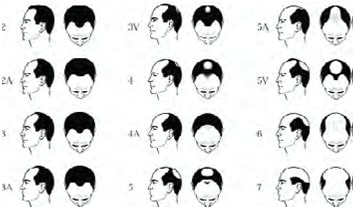
Paul Shapiro, MD, Cosmetic Beauty Magazzine Nov 2006 Pg 135-137
Synopsis: Two thirds of all men will experience male-patterned hair loss It is so common that it is considered a normal variant, not a disease. Paul Shapiro, MD explains the reason why so many men are affected.
Balding is a common problem that has afflicted men since the beginning of recorded history. It is said that Julius Caesar wore a wreath around his head at all times to disguise his balding. There are various reasons why men will lose hair, but 95 percent of the time it is from a condition called ‘androgenetic alopecia’ or Male Pattern Hair Loss (MPHL).
Male Pattern Hair Loss occurs gradually over time in a distinct pattern. At first the hair starts to thin in the frontal-temporal area of the head causing a distinctive M shaped pattern (figure 1). Hair loss then continues to progress over the temples, crown, and front of the head, spearing the sides and back. In the most advanced stages of balding, only a horse-shoe shaped pattern of hair is left on the sides and back of the head. Twenty percent of men will start to lose hair in their 20s and these men are at a higher risk of going completely bald. Up to 80 percent of men in their 70s show some sings of MPHL.
Male pattern of hair loss
We classify the degree of hair loss using a scale called the Norwood Hamilton Scale (figure 2). Most men with MPHL will follow a predictable pattern of hair loss progressing from one stage to the next. The scale is useful in describing one’s hair loss, predicting future hair loss and deciding on appropriate treatment. If you are experiencing hair loss that differs significantly from the Norwood Hamilton Scale or if you notice patchy hair loss, diffuse shedding of hair, breaking of the hair shafts, redness, scaling or pain with hair loss then most likely your hair loss is not from MPHL but from another condition and you should see a physician.
What causes MPHL?
To understand what causes MPHL one needs to under¬stand the natural growth cycle of a hair follicle and to know about a hormone named dihydrotestosterone. Hair growth is divided into three phases, anagen (the actively growing phase), catagen (a transitional phase) and telogen (a resting phase). At any one time 85 percent to 90 percent of the scalp hair follicles are in the active growth phase and they remain in this stage for about thee years. The rest of the scalp hair is either in the transitional or resting stage, which lasts for about three months.
We are constantly shedding and re-growing about 100 hairs a day. Balding starts when more hair is spent in the resting stage for longer periods of time and thus we shed more hair then we re-grow. These hairs progressively become finer, lighter in color, shorter, and grow at a slower rate. Eventually they cease to grow and death of the hair follicle results in complete balding.
Dihydrotestosterone (DHT)
The balding process described above is due mainly to the effect of the hormone dihydrotestosterone (DHT) on susceptible hair follicles. DHT is formed when testos¬terone is exposed to 5-alpha-reductase, an enzyme found mainly in hair follicles and the prostate.
All adult men have testosterone circulating in their blood. In the hair follicle the testosterone comes into contact with 5-alpha-reductase and is converted into DHT, which binds to specific receptors in the hair follicle cells. When DHT binds to a hair follicle cell, the follicle spends more time in the resting phase and eventually dies. We know that DHT is responsible for balding because men who have a genetic deficiency of 5-alpha-reductase cannot convert testosterone to DHT and these men do not suffer from MPHL.

Genetics
Research has shown that balding is inherited as a polygenetic trait, meaning that more then one gene is involved. The common belief that hair loss is a simple genetic trait that one inherits from the maternal side of thefamily is not true. The amount of 5-alpha reductase in the hair follicle and the sensitivity of the hair follicles to DHT are regulated by multiple genes inherited from both the father’s and mother’s side of the family. This polygenetic inheritance of MPHL explains why a family history of hair loss is only helpful in evaluating one’s future hair loss but is not 100 percent predictive. Genetics also explains why even in the most severe cases of MPHL, there is a fringe of hair on the sides and back of the head that never falls out. These hairs are genetically different then the rest of the scalp hair. These cells do not produce 5-alpha-reducatse and are resistant to the effects of DHT.
Treatments for hair loss
Understanding the genetics of hair loss and DHT’s detrimental effect on hair follicles enables one to understand the twomost effective treatments for MPHL. One treatment is an oral medication called finasteride (Propecia), and the other is hairtransplant surgery.
Finasteride (Propecia)
Finasteride (Propecia) is an oral medication that inhibits the enzyme 5-alpha-reductase and thus lowers the level of DHT in the hair follicle. In this way, the cascade of events mentioned above where DH promotes hair miniaturization and eventual death of the hair follicle is stopped or delayed. Finasteride at the 5mg dosewas originally used to treat men with benign enlargement of the prostate and has now been used for over 10 years with an excellent safety profile. While treating these men it was noticed it was also effective in treating MPHL. Propecia is the brand name for finasteride at the 1mg dose. We know that the 1mg dose is just as effective in treating hair loss as the 5mg dose but with almost no side effects. A small percentage of atients complain of decreased libido, erectile dysfunction, or decreased volume of ejaculate. These sexual side effects occur in less then two percent of men taking Propecia and resolve completely when the medication is stopped. Studies show that 65 percent of men taking ropecia regrow hair and nine out of 10 men taking Propecia have either improved or maintained hair. For Propecia to be effective it needs to be taken daily, and it takes at least three months to start seeing any beneficial effect. For some men it can take up to 12 months to see a benefit. If the medication is stopped, most men lose the hair gained within one year of stopping. The other medical treatment available to men with MPHL is minoxidil, a topical medication that is a non- specific stimulator of hair growth. It is safe and is sold overthe counter in a two percent and five percent dosage. It needs to be used daily to be effective and though it does have some benefit, in our experience it is not considered as effective as Propecia.
Surgery
Hair transplant surgery is the most effective treatment for MPHL and is the only treatment that gives permanent results. When it is performed by a skilled and experienced surgeon, a hair transplant should look full and natural. Most surgeons use a procedure called Follicular Unit Hair Transplantation, where a strip of hair is surgically removed from the back of the head, microscopically dissected, and then relocated to the balding area of the head. Since the donor hair comes from the horse-shoe shaped strip of hair that is genetically resistant to the effects of DHT, this transplanted hair is permanent.
Hair transplant surgery is a good option for the treatment of MPHL but does have its limitations. The donor supply is limited by the size of the strip of hair that can be removed. In younger patients with only stage 2 or 3 hair loss, it is difficult to predict exactly how much more hair loss they will experience in their lives. If you are considering surgery you should have morethan one consultation with a reputable hair transplant surgeon. For further information about hair transplantation surgery an excellent reference source is the International Society of Hair Restoration Surgeries website at www.ishrsorg or visit our website www.shapiromedical.com.
Summary
Balding is an inherited feature and follows a progressive, predictable pattern. There are both medical and surgical treatments available to help patients. If you are experiencing hair loss and wish to seek treatment, you should see a doctor who specializes in hair loss. Most hair transplant surgery practices provide free consultations in which all available options to treat your hair loss will be discussed.
In our practice we suggest Propecia for most of our patients. For some of our younger patients with stage 2 or 3 hair loss, Propecia promotes significant regrowth of hair. For patients who are suitable for hair transplant surgery, we still prescribe Propecia and find it is very effective in preventing further hair loss and is a good complement to surgery. Hair transplant surgery is the only permanent treatment for Male Pattern Hair Loss and, using the latest surgical techniques, a transplant should look natural, full and be undetectable. cbm


